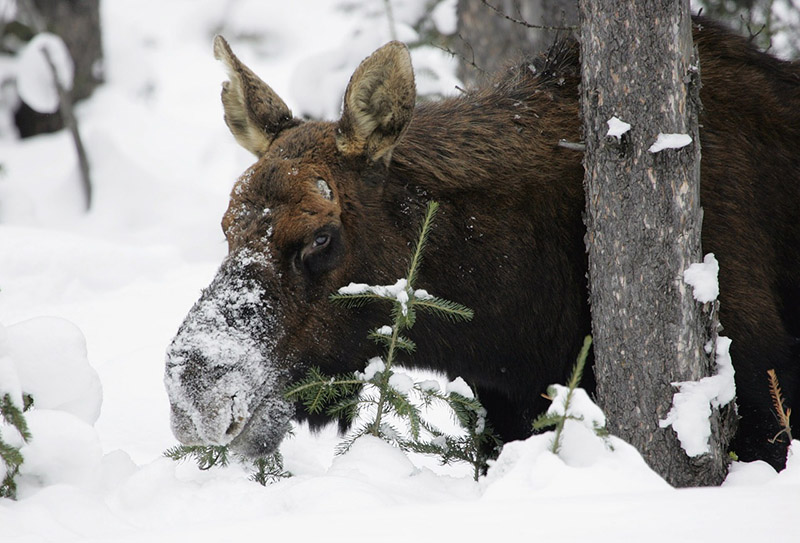by Frances Clark
Wildlife deals with winter in many ways: some leave the valley, many others stay year-round. They may go underground for the duration; adapt their hunting strategies to deep snow–burrowing below or plunging deep; or just keep on moving until they get lucky. Several members of our Nature Mapping community describe how their favorite animals cope:
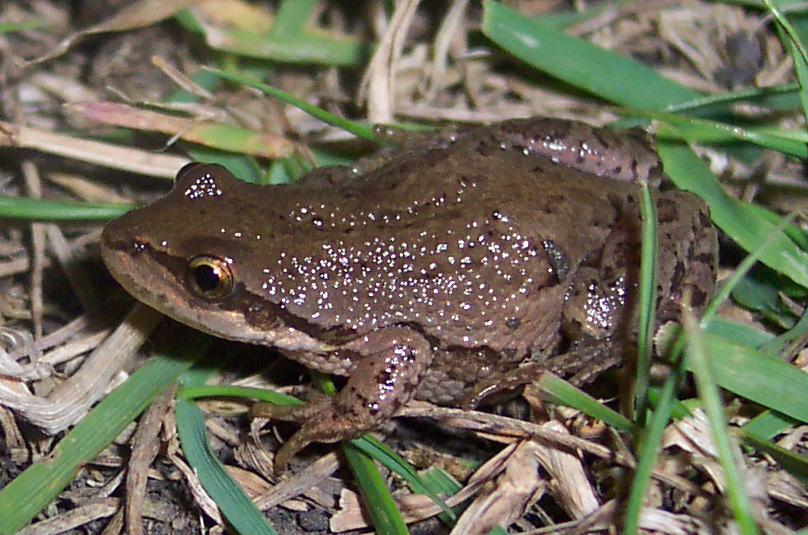
Boreal Chorus Frog Photo credit: Tnarg 12345 Wikimedia Commons
Amphibians – Debra Patla, Researcher
The four native amphibian species of Jackson Hole have three strategies to get through our harsh winters.
- Western Toads and Tiger Salamanders go underground, under the frost zone where they are safe from freezing.
- Columbia Spotted Frogs survive in water that does not freeze up, such as in underground springs, spring-fed streams and ponds.
- Boreal Chorus Frogs perform a winter miracle – staying near the ground surface under leaves or in small crevices, their bodies freeze in the coldest times and thaw as it warms up. It is a complicated physiological response to winter, shared by only four other amphibian species in North America.
Rarely, chorus frogs make a surprise appearance in winter, in a basement or garage. This has happened in Teton County! Kind rescuers have discovered that you can help them survive until spring by providing a box with moist, clean vegetation in a cool, dark place.
Beaver: Kari Cieszkiewicz, Winter Naturalist, National Elk Refuge
Beavers are highly industrious rodents that depend on meticulous winter preparation for survival. Before the first significant snowfall, beavers have already winterized their lodges and cached enough food, such as aspen, willow and cottonwood cuttings, for months. Since their teeth continuously grow, beaver must chew regularly on bark to maintain their teeth! These highly productive animals spend the summer months obsessively monitoring their ponds, ensuring that their dams are supporting enough water so ponds do not freeze to the bottom or prohibit access to their lodges.
Short-tailed Weasels (Ermine) – Kari Cieszkiewicz, Winter Naturalist, National Elk Refuge
Short-tailed weasels are highly adapted, masterful carnivores that have a surprisingly commanding presence in winter. Their elongated, slender bodies facilitate easy movement through tunnels in the snow, leading them to unsuspecting mice and voles. When the prey is bountiful, weasels will often store their leftover prey in caches beneath the snow for later feasting! During the winter months their fur changes color from tawny-brown to white, allowing them to be camouflage as they discreetly move across the snow.
Boreal Owl – Susan Marsh – Writer, Naturalist
Among our forest winter residents is a small predator, the Boreal Owl. Their coloration allows them to blend in well when perched in a tree so they are easily missed, but in the spruce-fir forests of winter, they are likely around. They hunt small mammals by ambush, from red-backed tree voles to squirrels. The photo, taken by Jim Hawley in lower Cache Creek, shows a Boreal Owl having just caught a red squirrel.

Boreal Owl Photo credit: Jim Hawly
Interesting adaptations that are especially helpful in winter include the asymmetry of the owl’s ears, found in other owl species as well. One opening is higher on the skull and the other much lower. The positions help the owl tell where a sound is coming from. I tried cocking my head in mimic but was woefully inept at finding a flock of chickadees without my eyes. The owl, on the other hand, can locate prey even under the snow.
Great Gray Owl – Katherine Gura, Field Biologist, Teton Raptor Center
A boreal forest raptor species that is circumpolar, found in the northern reaches of North America, Europe and Asia, Great Gray Owls are well-suited to brave the long, harsh winters in Jackson Hole. Locally, Great Gray Owls generally migrate down in elevation in wintertime and are often seen grouped up in the Snake River bottom where presumably there is less snow and more prey available. Equipped with exceptional hearing abilities, Great Gray Owls hunt primarily by sound and penetrate through as much as two feet of snow to capture rodents that are not visible.
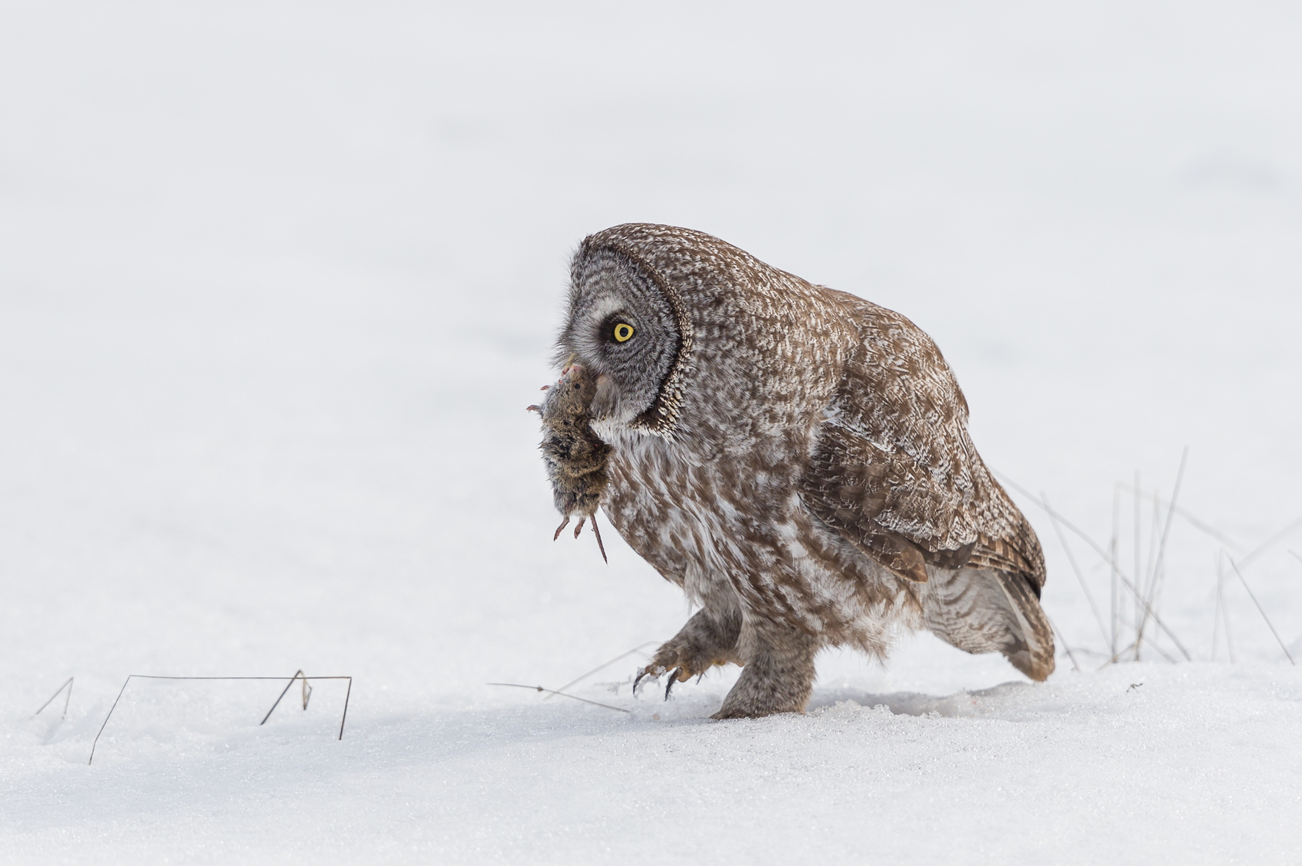
Great Grey Owl Photo Credit: Steve Mattheis
Rough-legged Hawk – Katherine Gura, Field Biologist, Teton Raptor Center
While many species (and people) in Jackson Hole are “snowbirds,” spending summers here and wintering farther south in warmer climes, the Rough-legged Hawk is an exception. In summer months, Rough-legged Hawks breed in the arctic tundra, then migrate south to spend the winter in more “mild” areas in southern Canada and the northern United States. This past year, a Rough-legged Hawk outfitted with a transmitter in northwestern Wyoming migrated north through Alberta and the Northwest territories and finally summered in Nunavut before returning south this fall through Manitoba, Saskatchewan and Alberta. In the wintertime, look for these hawks perched on fence lines and power poles in open areas in the Valley.
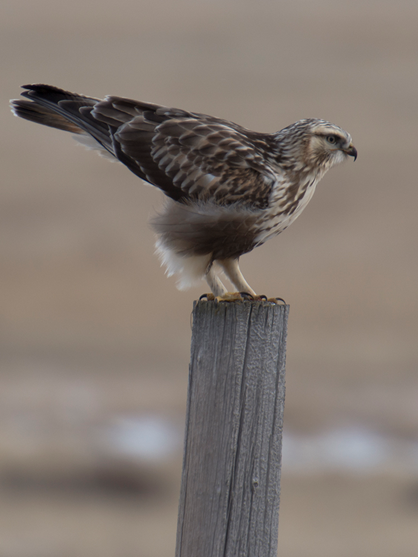
Rough-legged Hawk Photo Credit: Steve Poole
Coyote: Kari Cieszkiewicz, Winter Naturalist National Elk Refuge
As the sun begins to cast its warming light on the snow-covered meadow, a coyote can be seen making very thoughtful, directed movements. Beneath the snow there is a secret society of critters that live in the subnivean (under snow) zone and the coyote can sense their presence. Using its powerful nose, the coyote sniffs at the ground and precisely locates its prey. With one powerful and swift dive-bomb into the snow head-first, the coyote emerges with its breakfast. Based on what prey is available, coyotes are highly adaptable, adjusting their hunting techniques based on their food source.
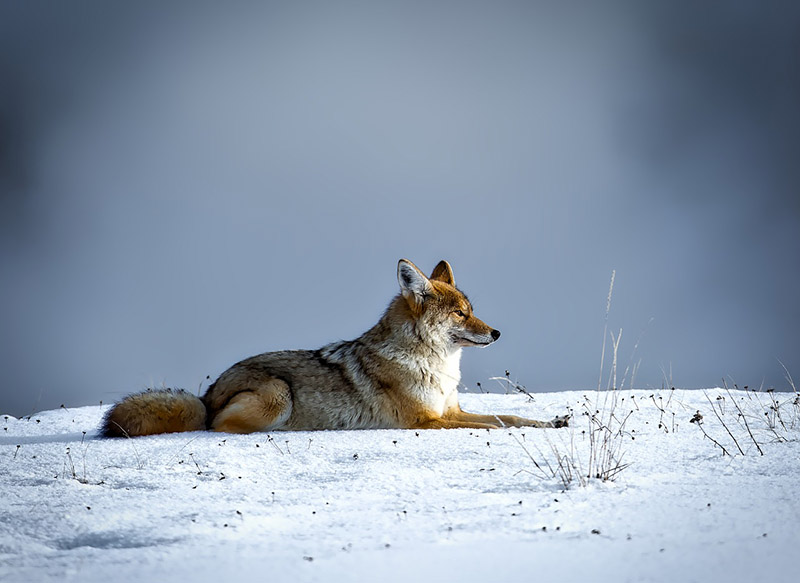
Moose – Kerry Murphy – Bridger-Teton National Forest Service
With its long legs and large body, moose are adapted to deep snow and long winters. When deep snow is present, moose are surprisingly sedentary, tending to range over very small areas, browsing on shrubs. Surprisingly, moose may move to high elevation conifer forests during the winter, foraging on lichens that hang from conifer boughs. The large body size of moose affords them a favorable surface-to-volume ratio that increases their heat retention, a distinct advantage over smaller ungulates such as deer.
